Study on Ultraviolet Aging Mechanism of Carbon Nanotubes/SBS Composite-Modified Asphalt in Two-Dimensional Infrared Correlation Spectroscopy
Abstract
:1. Introduction
2. Materials and Methods
2.1. Materials
2.2. Methods
2.2.1. Sample Preparation
2.2.2. UV Aging Test
2.2.3. Dynamic Shear Rheology Test
2.2.4. Infrared Spectrum Test
3. Results and Discussion
3.1. Rheological Properties of CSCMAB
3.2. Infrared Spectrum Test
3.3. Two-Dimensional Infrared Spectrum
3.3.1. Two-Dimensional Synchronous Correlation Infrared Spectrum
3.3.2. Two-Dimensional Asynchronous Infrared Correlation Spectrum
4. Conclusions
Author Contributions
Funding
Institutional Review Board Statement
Informed Consent Statement
Data Availability Statement
Conflicts of Interest
References
- Burakova, E.A.; Dyachkova, T.; Rukhov, A.V.; Tugolukov, E.N.; Galunin, E.V.; Tkachev, A.G.; Basheer, A.A.; Ali, I. Novel and economic method of carbon nanotubes synthesis on a nickel magnesium oxide catalyst using microwave radiation. J. Mol. Liq. 2018, 253, 340–346. [Google Scholar] [CrossRef]
- Wang, H.; Li, P.; Yu, D.; Zhang, Y.; Wang, Z.; Liu, C.; Qiu, H.; Liu, Z.; Ren, J.; Qu, X. Unraveling the Enzymatic Activity of Oxygenated Carbon Nanotubes and Their Application in the Treatment of Bacterial Infections. Nano Lett. 2018, 18, 3344–3351. [Google Scholar] [CrossRef] [PubMed]
- Xie, J.; Ma, J.; Wu, L.; Xu, M.; Ni, W.; Yan, Y.-M. Carbon nanotubes in-situ cross-linking the activated carbon electrode for high-performance capacitive deionization. Sep. Purif. Technol. 2020, 239, 116593. [Google Scholar] [CrossRef]
- Shuwen, Z.H.A.N.G.; Jie, Z.H.A.N.G.; Guichun, W.A.N.G.; Danying, G.A.O. Effect of Carbon Nanotubes on Thermal Expansion Properties of Cement-based Materials. Chin. J. Mater. Res. 2019, 33, 387–393. [Google Scholar]
- Shi, T.; Zexin, L.; Shanshan, L. Autogenous shrinkage and crack resistance of carbon nanotubes reinforced cement based composites. Acta Mater. Compos. Sin. 2019, 36, 1528–1535. [Google Scholar]
- Zhou, X.; Zhang, X.; Xu, S.; Wu, S.; Liu, Q.; Fan, Z. Evaluation of thermo-mechanical properties of graphene/carbon-nanotubes modified asphalt with molecular simulation. Mol. Simul. 2017, 43, 312–319. [Google Scholar] [CrossRef]
- Trichês, J.V.S.d.M.G. Evaluation of Rheological Behavior and Performance to Permanent Deformation of Nanomodified Asphalt Mixtures with Carbon Nanotubes (CNTs). Can. J. Civ. Eng. 2016, 43, 1–38. [Google Scholar]
- de Melo, J.V.S.; Trichês, G.; de Rosso, L.T. Experimental evaluation of the influence of reinforcement with Multi-Walled Carbon Nanotubes (MWCNTs) on the properties and fatigue life of hot mix asphalt. Constr. Build. Mater. 2018, 162, 369–382. [Google Scholar] [CrossRef]
- Amin, I.; El-Badawy, S.M.; Breakah, T.; Ibrahim, M.H.Z. Laboratory evaluation of asphalt binder modified with carbon nanotubes for Egyptian climate. Constr. Build. Mater. 2016, 121, 361–372. [Google Scholar] [CrossRef]
- Arabani, M.; Faramarzi, M. Characterization of CNTs-modified HMA’s mechanical properties. Constr. Build. Mater. 2015, 83, 207–215. [Google Scholar] [CrossRef]
- Ameri, M.; Nowbakht, S.; Molayem, M.; Mohammadaliha, M. Investigation of fatigue and fracture properties of asphalt mixtures modified with carbon nanotubes. Fatigue Fract. Eng. Mater. Struct. 2016, 39, 896–906. [Google Scholar] [CrossRef]
- Saltan, M.; Terzi, S.; Karahancer, S. Performance analysis of nano modified bitumen and hot mix asphalt. Constr. Build. Mater. 2018, 173, 228–237. [Google Scholar] [CrossRef]
- Mansourkhaki, A.; Aghasi, A. Low-temperature fracture resistance of asphalt mixtures modified with carbon nanotubes. Proc. Inst. Civ. Eng.-Transp. 2021, 174, 78–86. [Google Scholar] [CrossRef]
- Goli, A.A.; Ziari, H.; Amini, A. Influence of Carbon Nanotubes on Performance Properties and Storage Stability of SBS Modified Asphalt Binders. J. Mater. Civ. Eng. 2017, 29, 04017070. [Google Scholar] [CrossRef]
- Haq, M.F.U.; Ahmad, N.; Nasir, M.A.; Jamal, M.H.; Hafeez, M.; Rafi, J.; Zaidi, S.B.A.; Haroon, W. Carbon Nanotubes (CNTs) in Asphalt Binder: Homogeneous Dispersion and Performance Enhancement. Appl. Sci. 2018, 8, 2651. [Google Scholar] [CrossRef] [Green Version]
- Wang, R.; Yue, J.; Li, R.; Sun, Y. Evaluation of Aging Resistance of Asphalt Binder Modified with Graphene Oxide and Carbon Nanotubes. J. Mater. Civ. Eng. 2019, 31, 04019274. [Google Scholar] [CrossRef]
- Wang, P.; Dong, Z.; Tan, Y.; Liu, Z.-Y. Anti-ageing properties of styrene–butadiene–styrene copolymer-modified asphalt combined with multi-walled carbon nanotubes. Road Mater. Pavement Des. 2016, 18, 533–549. [Google Scholar] [CrossRef]
- Tang, N.; Yang, Y.; Fang, T.; Wang, W.; Cao, S.; Pan, W. Aging Behavior of Bitumen Based on Three-Dimensional Fluorescence Spectroscopy. Spectrosc. Spectr. Anal. 2018, 39, 2828–2834. [Google Scholar]
- Zhang, Q.; Hou, D.; Shi, J. Research Progress of Microscopic Characterization of Rubber Asphalt. Mater. Rep. 2019, 33, 247–253. [Google Scholar]
- Jiang, W.; Li, P.; Ye, W.; Shan, J.; Li, Y.; Xiao, J. The effect and mechanism of La2O3 on the anti-ultraviolet aging characteristics of virgin bitumen. Constr. Build. Mater. 2020, 230, 116967. [Google Scholar] [CrossRef]
- Liu, L.; Liu, Z.; Hong, L.; Huang, Y. Effect of ultraviolet absorber (UV-531) on the properties of SBS-modified asphalt with different block ratios. Constr. Build. Mater. 2020, 234, 117388. [Google Scholar] [CrossRef]
- Xu, J.; Li, R.; Liu, T.; Pei, J.; Li, Y.; Luo, Q. Study on the Effect of Microwave Processing on Asphalt-Rubber. Materials 2020, 13, 411. [Google Scholar] [CrossRef] [PubMed] [Green Version]
- Fang, J.; Tu, J. Effect of ultraviolet (UV) aging on rheology properties and microstructure of polyurethane (PU) modified asphalt. Mater. Res. Express 2019, 6, 125318. [Google Scholar] [CrossRef]
- Ma, D.; Liu, G.; Ou, Q.; Yu, H.; Li, H.; Shi, Y. Discrimination of Common Wild Mushrooms by FTIR and Two-Dimensional Correlation Infrared Spectroscopy. Spectrosc. Spectr. Anal. 2018, 38, 2113–2122. [Google Scholar]
- Wu, F.; Zhang, Y.; Liu, W.; Zhu, N.; Chen, J.; Sun, Z. Comparison of torrefied and lyophilized Dendrobii Officinalis Caulis (Tiepishihu) by Fourier transform infrared spectroscopy and two-dimensional correlation spectroscopy. J. Mol. Struct. 2020, 1204, 127554. [Google Scholar] [CrossRef]
- Sohng, W.; Park, Y.; Jang, D.; Cha, K.; Jung, Y.M.; Chung, H. Incorporation of two-dimensional correlation analysis into discriminant analysis as a potential tool for improving discrimination accuracy: Near-infrared spectroscopic discrimination of adulterated olive oils. Talanta 2020, 212, 120748. [Google Scholar] [CrossRef]
- LI, L.; Ma, G.; Cheng, Y.; Zhu, C.; Xu, M.; Xu, X. Study on Performance of Diatomite and Basalt Fiber Compound Modified Asphalt Based on DSR Test. Mater. Rep. 2018, 32, 484–488. [Google Scholar]
- Yu, J.; Luo, X.; Wu, S.; Zeng, X.; Cong, P. Preparation and Properties of Flame-retarded SBS Modified Asphalt. China J. High Way Transp. 2007, 20, 35–39. [Google Scholar]
- Wang, F.; Zhang, L.; Yan, B.; Kong, D.; Li, Y.; Wu, S. Diffusion Mechanism of Rejuvenator and Its Effects on the Physical and Rheological Performance of Aged Asphalt Binder. Materials 2019, 12, 4130. [Google Scholar] [CrossRef] [PubMed] [Green Version]
- Xie, S.; Xu, W.; Su, Y. The Analysis on Anti-aging Performance of Carbon Nanotubes/SBS Compound Modified Asphalt Based on DSR Test. Synth. Mater. Aging Appl. 2020, 49, 4–7. [Google Scholar]
- Zhao, Y.; Gu, F.; Huang, X. Analysis on SBS Modified Asphalt Aging Fourier Transform Infrared Characterization Based on Spectroscopy. J. Build. Mater. 2011, 14, 620–623. [Google Scholar]
- Yao, H.; Dai, Q.; You, Z. Fourier Transform Infrared Spectroscopy characterization of aging-related properties of original and nano-modified asphalt binders. Constr. Build. Mater. 2015, 101, 1078–1087. [Google Scholar] [CrossRef]
- Horch, M.; Schoknecht, J.; Wrathall, S.L.D.; Greetham, G.M.; Lenz, O.; Hunt, N.T. Understanding the structure and dynamics of hydrogenases by ultrafast and two-dimensional infrared spectroscopy. Chem. Sci. 2019, 10, 8981–8989. [Google Scholar] [CrossRef] [PubMed] [Green Version]
- Qu, L.; Chen, J.-B.; Zhou, Q.; Zhang, G.-J.; Sun, S.-Q.; Guo, Y.-Z. Identification of authentic and adulterated Aquilariae Lignum Resinatum by Fourier transform infrared (FT-IR) spectroscopy and two-dimensional correlation analysis. J. Mol. Struct. 2016, 1124, 216–220. [Google Scholar] [CrossRef]
- Chen, H.; Li, C.; Sun, J.; He, Q. Effect of interactive aging considering ultraviolet on rheological properties of SBR modified asphalt and analysis of the aging mechanism. J. Chongqing Univ. 2019, 42, 54–62. [Google Scholar]
- Wu, W.; Jin, Y.; Wu, J.; Zhang, Y. Analysis of lignin modified asphalt by infrared spectrum. J. Jiangsu Univ. (Nat. Sci. Ed.) 2019, 40, 120–124. [Google Scholar]
- Shen, T.; Fu, C.; Mu, Z.; Zhang, Z.; Bao, M. Two-Dimensional Infrared Correlation Spectroscopy Analysis. J. Univ. Jinan Sci. Technol. 2007, 21, 124–129. [Google Scholar]


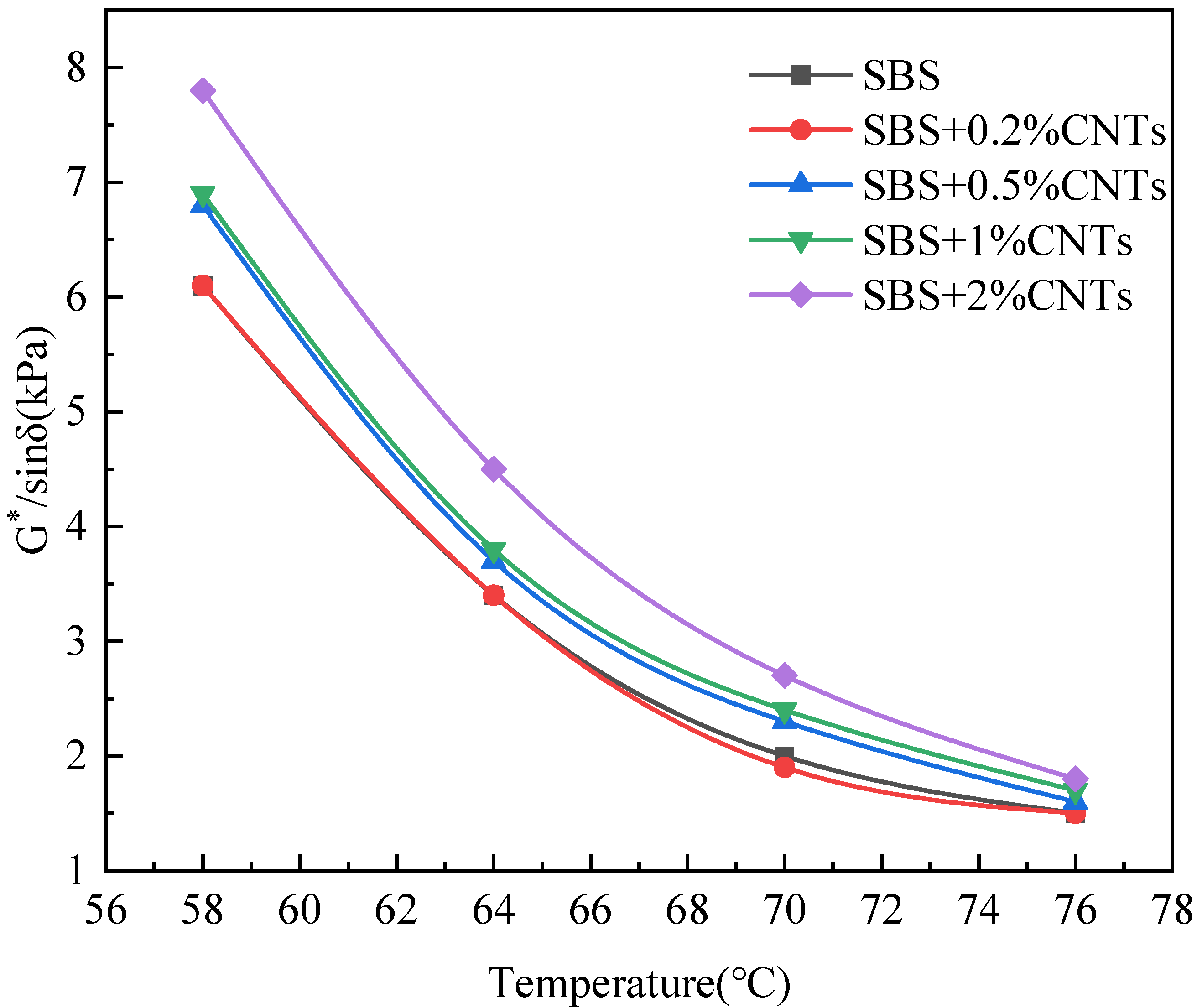
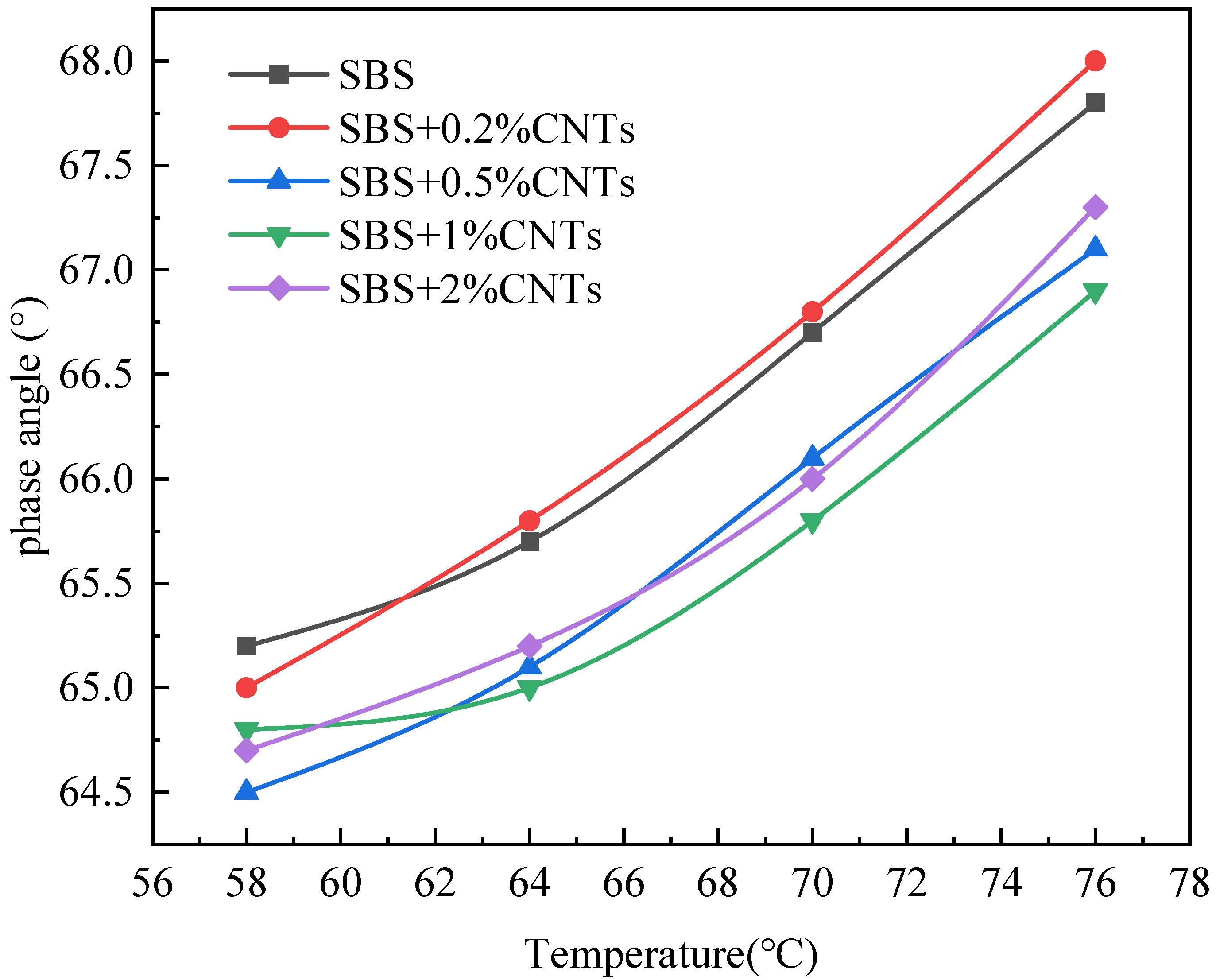
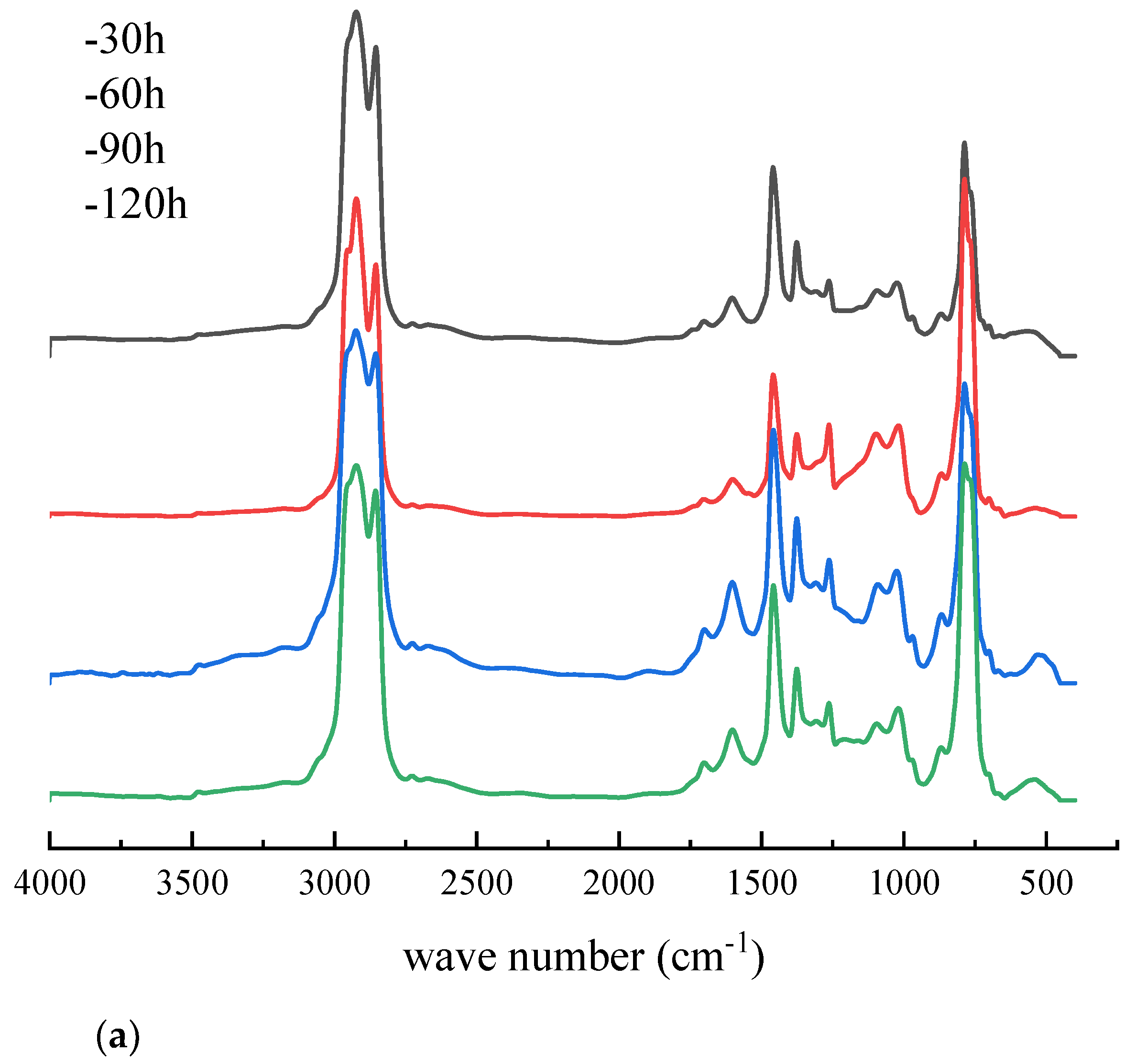
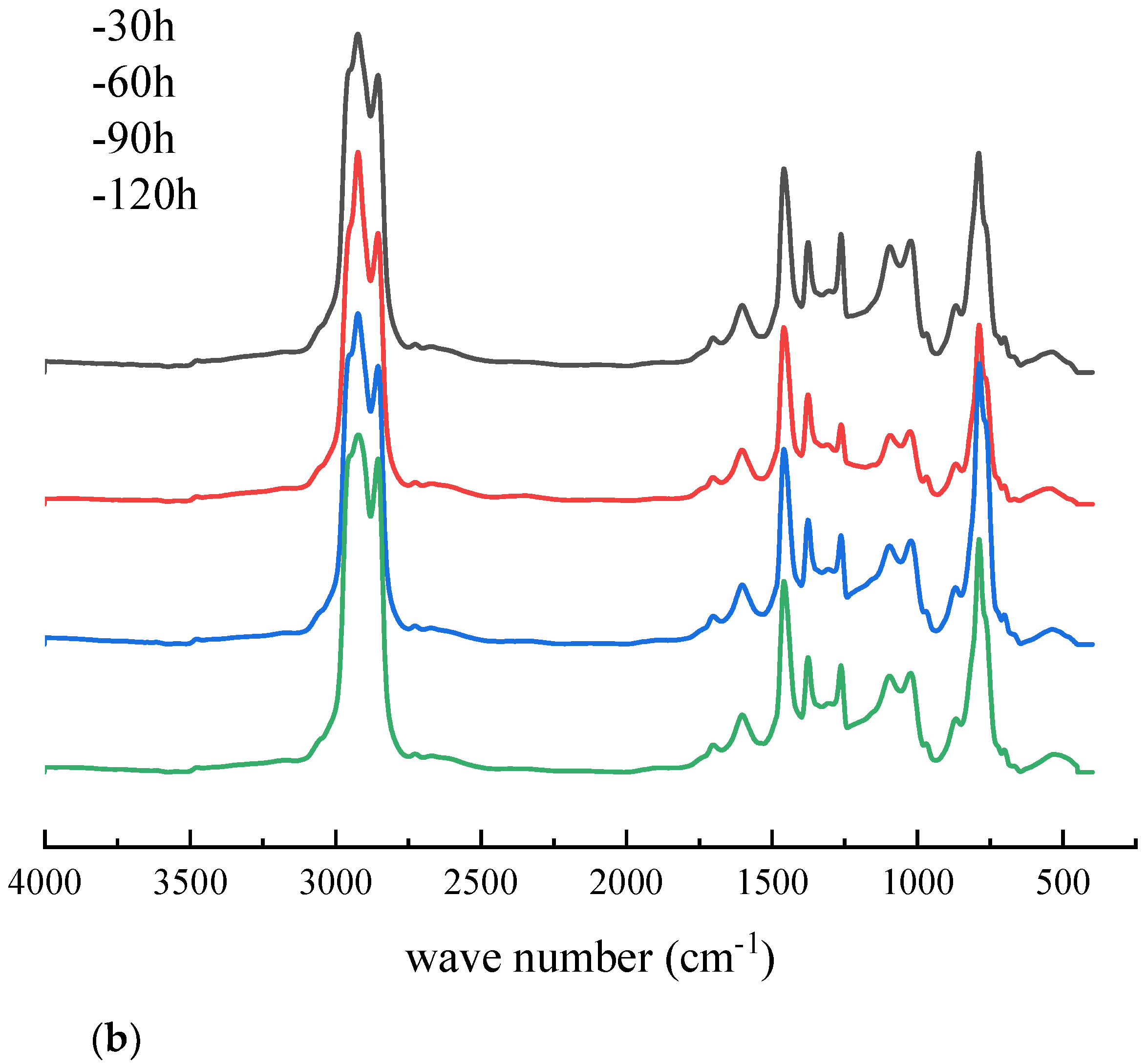


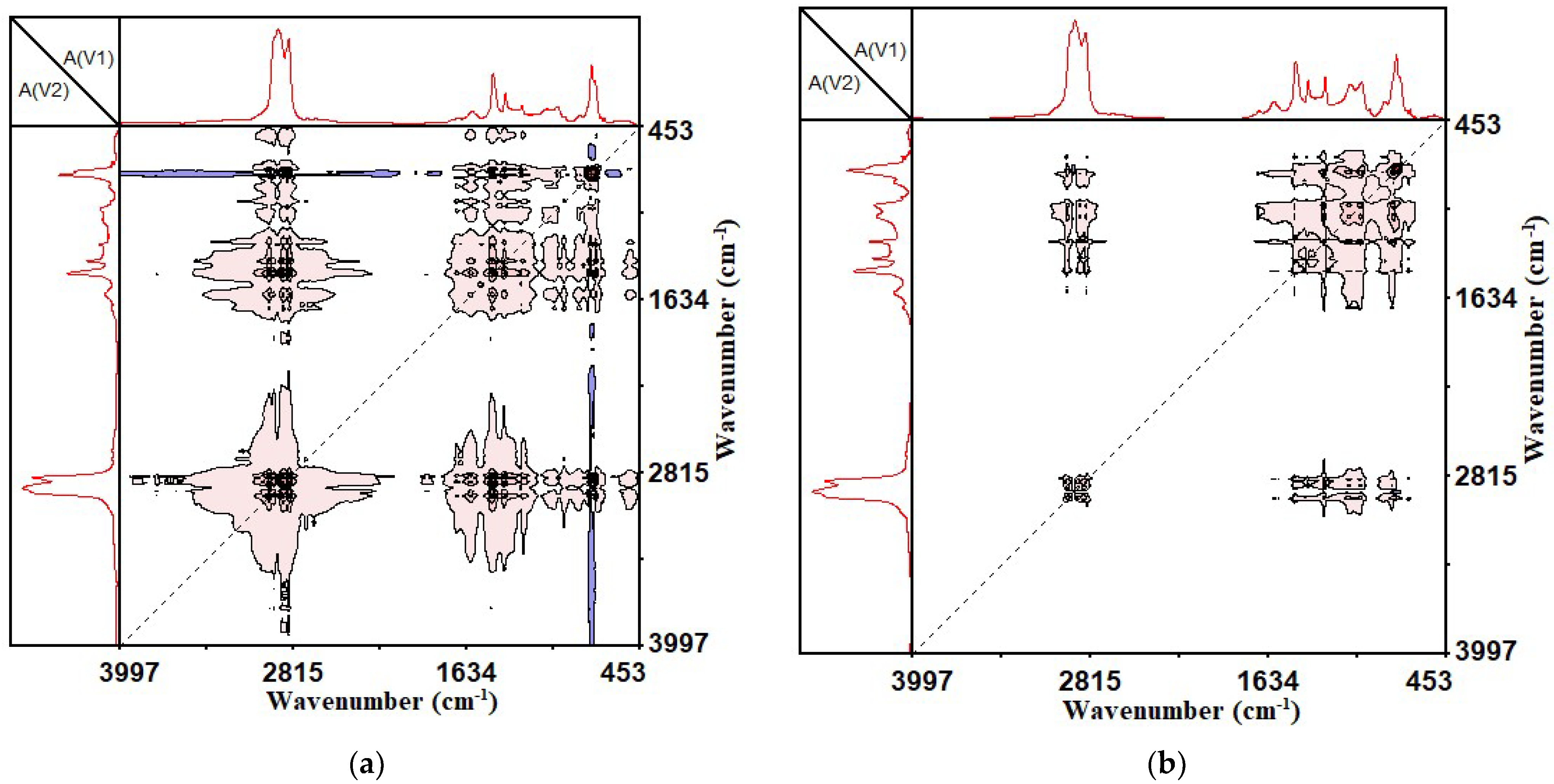
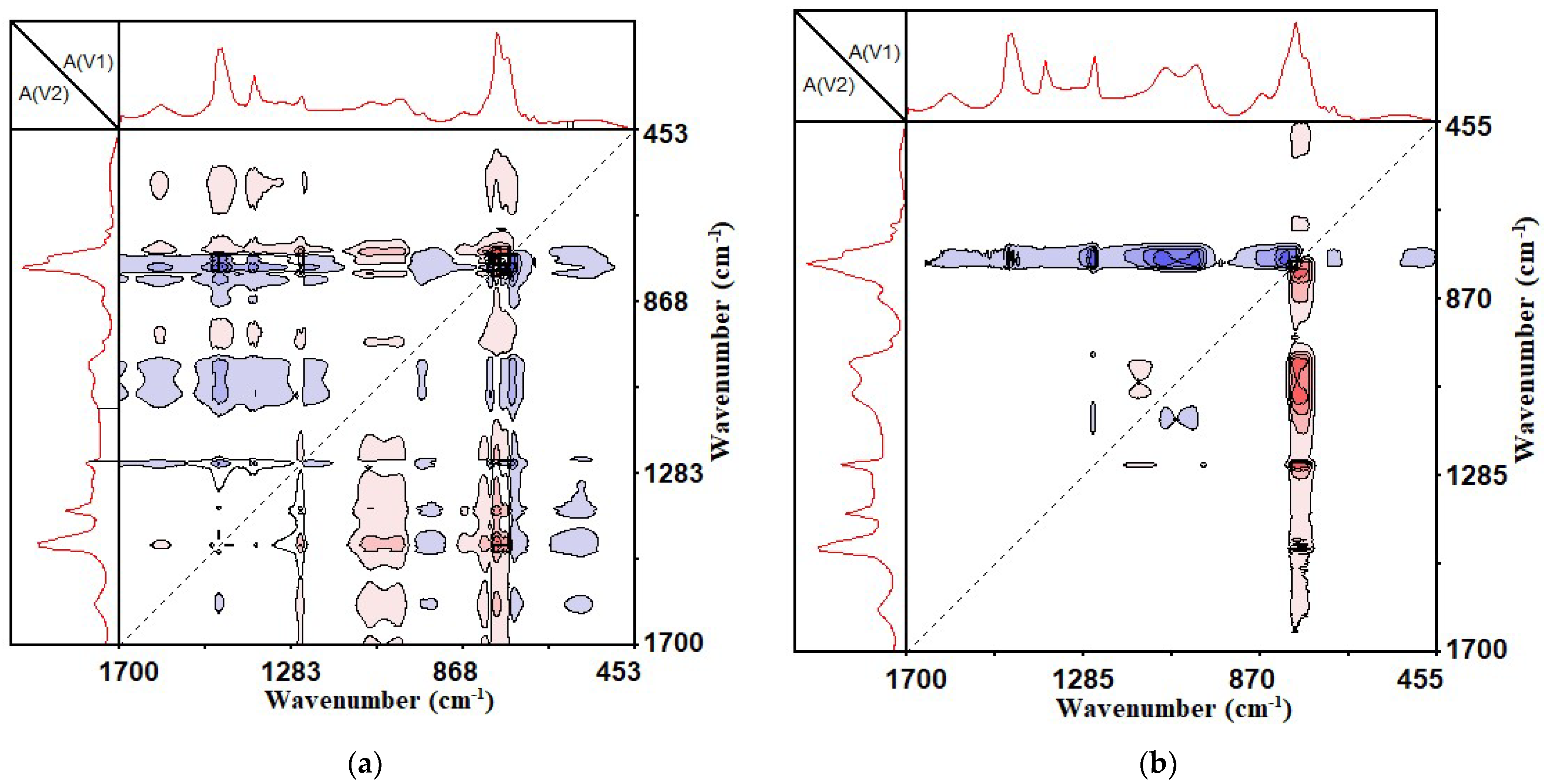

| Properties | Test Results | Methods |
|---|---|---|
| Penetration (25 °C, 0.1 mm) | 69.1 | JTG E20-2011 T0604 |
| Softening Point (°C) | 60.5 | JTG E20-2011 T0606 |
| Ductility (5 °C, cm) | 33 | JTG E20-2011 T0605 |
| No. | Test Items | Unit | Eligibility Criteria | |
|---|---|---|---|---|
| 1 | Pipe diameter | Nm | 10–20 | |
| 2 | Tube length | Μm | 5–15 | |
| 3 | Purity | % | ≥97.5 | |
| 4 | Ash | % | ≤2.5 | |
| 5 | Specific surface area | m2/g | 240–280 | |
| 6 | Tap density | g/cm3 | 0.06–0.09 | |
| 7 | Resistivity | mΩ·cm | 80–100 | |
| 8 | Metal content | Fe | Ppm | ≤4500 |
| Co | Ppm | ≤4500 | ||
| Ni | Ppm | ≤100 | ||
| Cu | Ppm | ≤10 | ||
| Zn | Ppm | ≤10 | ||
| Cr | Ppm | ≤10 | ||
Publisher’s Note: MDPI stays neutral with regard to jurisdictional claims in published maps and institutional affiliations. |
© 2021 by the authors. Licensee MDPI, Basel, Switzerland. This article is an open access article distributed under the terms and conditions of the Creative Commons Attribution (CC BY) license (https://creativecommons.org/licenses/by/4.0/).
Share and Cite
Zheng, X.; Xu, W.; Xie, S. Study on Ultraviolet Aging Mechanism of Carbon Nanotubes/SBS Composite-Modified Asphalt in Two-Dimensional Infrared Correlation Spectroscopy. Materials 2021, 14, 5672. https://doi.org/10.3390/ma14195672
Zheng X, Xu W, Xie S. Study on Ultraviolet Aging Mechanism of Carbon Nanotubes/SBS Composite-Modified Asphalt in Two-Dimensional Infrared Correlation Spectroscopy. Materials. 2021; 14(19):5672. https://doi.org/10.3390/ma14195672
Chicago/Turabian StyleZheng, Xuewen, Wenyuan Xu, and Shuangrui Xie. 2021. "Study on Ultraviolet Aging Mechanism of Carbon Nanotubes/SBS Composite-Modified Asphalt in Two-Dimensional Infrared Correlation Spectroscopy" Materials 14, no. 19: 5672. https://doi.org/10.3390/ma14195672





